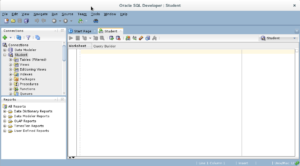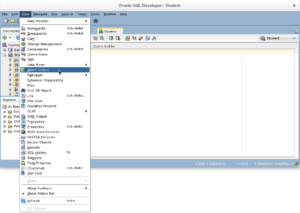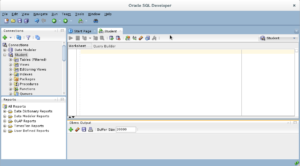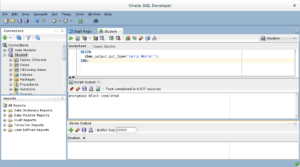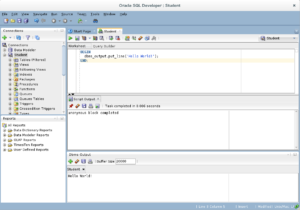Archive for the ‘Oracle Developer’ tag
Oracle Diagnostic Queries
It’s always a challenge when you want to build your own Oracle SQL Tools. I was asked how you could synchronize multiple cursors into a single source. The answer is quite simple, you write an Oracle object type to represent a record structure, an Oracle list of the record structure, and a stored function to return the list of the record structure.
For this example, you create the following table_struct object type and a table_list collection type:
/* Drop the types from most to least dependent. */ DROP TYPE table_list; DROP TYPE table_struct; /* Create the record type structure. */ CREATE OR REPLACE TYPE table_struct IS OBJECT ( table_name VARCHAR2(30) , column_cnt NUMBER , row_cnt NUMBER ); / /* Create the collection of a record type structure. */ CREATE OR REPLACE TYPE table_list IS TABLE OF table_struct; / |
The following listing function now reads all table names from the user_tables view. A subordinate cursor reads the user_tab_columns view for the number of columns in a table. A Native Dynamic SQL (NDS) cursor counts the number of rows in each tables found in the .
/* Create the listing function. */
CREATE OR REPLACE
FUNCTION listing RETURN table_list IS
/* Variable list. */
lv_column_cnt NUMBER;
lv_row_cnt NUMBER;
/* Declare a statement variable. */
stmt VARCHAR2(200);
/* Declare a system reference cursor variable. */
lv_refcursor SYS_REFCURSOR;
lv_table_cnt NUMBER;
/* Declare an output variable. */
lv_list TABLE_LIST := table_list();
/* Declare a table list cursor that excludes APEX tables. */
CURSOR c IS
SELECT table_name
FROM user_tables
WHERE table_name NOT IN
('DEPT','EMP','APEX$_ACL','APEX$_WS_WEBPG_SECTIONS','APEX$_WS_ROWS'
,'APEX$_WS_HISTORY','APEX$_WS_NOTES','APEX$_WS_LINKS'
,'APEX$_WS_TAGS','APEX$_WS_FILES','APEX$_WS_WEBPG_SECTION_HISTORY'
,'DEMO_USERS','DEMO_CUSTOMERS','DEMO_ORDERS','DEMO_PRODUCT_INFO'
,'DEMO_ORDER_ITEMS','DEMO_STATES');
/* Declare a column count. */
CURSOR cnt
( cv_table_name VARCHAR2 ) IS
SELECT table_name
, COUNT(column_id) AS cnt_columns
FROM user_tab_columns
WHERE table_name = cv_table_name
GROUP BY table_name;
BEGIN
/* Read through the data set of non-environment variables. */
FOR i IN c LOOP
/* Count the columns of a table. */
FOR j IN cnt(i.table_name) LOOP
lv_column_cnt := j.cnt_columns;
END LOOP;
/* Declare a statement. */
stmt := 'SELECT COUNT(*) AS column_cnt FROM '||i.table_name;
/* Open the cursor and write set to collection. */
OPEN lv_refcursor FOR stmt;
LOOP
FETCH lv_refcursor INTO lv_table_cnt;
EXIT WHEN lv_refcursor%NOTFOUND;
lv_list.EXTEND;
lv_list(lv_list.COUNT) := table_struct(
table_name => i.table_name
, column_cnt => lv_column_cnt
, row_cnt => lv_table_cnt );
END LOOP;
END LOOP;
RETURN lv_list;
END;
/ |
The following query pulls the processed data set as the function’s result:
COL table_name FORMAT A20 HEADING "Table Name" COL column_cnt FORMAT 9,999 HEADING "Column #" COL row_cnt FORMAT 9,999 HEADING "Row #" SELECT table_name , column_cnt , row_cnt FROM TABLE(listing); |
It returns the following result set:
Table Name Column # Row # -------------------- -------- ------ SYSTEM_USER 11 5 COMMON_LOOKUP 10 49 MEMBER 9 10 CONTACT 10 18 ADDRESS 10 18 STREET_ADDRESS 8 28 TELEPHONE 11 18 RENTAL 8 4,694 ITEM 14 93 RENTAL_ITEM 9 4,703 PRICE 11 558 TRANSACTION 12 4,694 CALENDAR 9 300 AIRPORT 9 6 ACCOUNT_LIST 8 200 15 rows selected. |
As always, I hope this helps those trying to work with the Oracle database.
Install cx_Oracle for Python
This shows you how to install the cx_Oracle library for Python 2.7 on Fedora Linux. If Fedora has it on the server you can download it with the following yum command:
yum install -y cx_Oracle-5.2.1-11g-py27-1.x86_64.rpm |
Currently, you’ll get the following failure because it’s not available in the Fedora repository:
Loaded plugins: langpacks, refresh-packagekit mysql-connectors-community | 2.5 kB 00:00:00 mysql-tools-community | 2.5 kB 00:00:00 mysql56-community | 2.5 kB 00:00:00 pgdg93 | 3.6 kB 00:00:00 updates/20/x86_64/metalink | 2.3 kB 00:00:00 No package cx_Oracle-5.2.1-11g-py27-1.x86_64.rpm available. Error: Nothing to do |
You can download the cx_Oracle library from the Python web site. The cx_Oracle documentation qualifies module interfaces, objects, and connections. Assuming your Linux user’s name is student, you download the cx_Oracle library into the /home/student/Downloads directory. Then, you use the su or sudo command to become the root user.
As the root user, run the following yum command:
yum install -y ~student/Downloads/cx_Oracle-5.2.1-11g-py27-1.x86_64.rpm |
You should see the following output:
Loaded plugins: langpacks, refresh-packagekit Examining /home/student/Downloads/cx_Oracle-5.2.1-11g-py27-1.x86_64.rpm: cx_Oracle-5.2.1-1.x86_64 Marking /home/student/Downloads/cx_Oracle-5.2.1-11g-py27-1.x86_64.rpm to be installed Resolving Dependencies --> Running transaction check ---> Package cx_Oracle.x86_64 0:5.2.1-1 will be installed --> Finished Dependency Resolution Dependencies Resolved ======================================================================================= Package Arch Version Repository Size ======================================================================================= Installing: cx_Oracle x86_64 5.2.1-1 /cx_Oracle-5.2.1-11g-py27-1.x86_64 717 k Transaction Summary ======================================================================================= Install 1 Package Total size: 717 k Installed size: 717 k Downloading packages: Running transaction check Running transaction test Transaction test succeeded Running transaction (shutdown inhibited) Installing : cx_Oracle-5.2.1-1.x86_64 1/1 Verifying : cx_Oracle-5.2.1-1.x86_64 1/1 Installed: cx_Oracle.x86_64 0:5.2.1-1 Complete! |
After you install the cx_Oracle-5.2.1-1.x86_64 package, you can find the installed files with this rpm command:
rpm -ql cx_Oracle-5.2.1-1.x86_64 |
It lists:
/usr/lib64/python2.7/site-packages/cx_Oracle-5.2.1-py2.7.egg-info /usr/lib64/python2.7/site-packages/cx_Oracle-5.2.1-py2.7.egg-info/PKG-INFO /usr/lib64/python2.7/site-packages/cx_Oracle-5.2.1-py2.7.egg-info/SOURCES.txt /usr/lib64/python2.7/site-packages/cx_Oracle-5.2.1-py2.7.egg-info/dependency_links.txt /usr/lib64/python2.7/site-packages/cx_Oracle-5.2.1-py2.7.egg-info/top_level.txt /usr/lib64/python2.7/site-packages/cx_Oracle.so /usr/share/doc/cx_Oracle-5.2.1 /usr/share/doc/cx_Oracle-5.2.1/BUILD.txt /usr/share/doc/cx_Oracle-5.2.1/README.txt /usr/share/doc/cx_Oracle-5.2.1/samples /usr/share/doc/cx_Oracle-5.2.1/samples/DatabaseChangeNotification.py /usr/share/doc/cx_Oracle-5.2.1/samples/DatabaseShutdown.py /usr/share/doc/cx_Oracle-5.2.1/samples/DatabaseStartup.py /usr/share/doc/cx_Oracle-5.2.1/samples/ReturnLongs.py /usr/share/doc/cx_Oracle-5.2.1/samples/ReturnUnicode.py /usr/share/doc/cx_Oracle-5.2.1/samples/RowsAsInstance.py /usr/share/doc/cx_Oracle-5.2.1/test /usr/share/doc/cx_Oracle-5.2.1/test/3kArrayDMLBatchError.py /usr/share/doc/cx_Oracle-5.2.1/test/3kNumberVar.py /usr/share/doc/cx_Oracle-5.2.1/test/3kStringVar.py /usr/share/doc/cx_Oracle-5.2.1/test/ArrayDMLBatchError.py /usr/share/doc/cx_Oracle-5.2.1/test/BooleanVar.py /usr/share/doc/cx_Oracle-5.2.1/test/Connection.py /usr/share/doc/cx_Oracle-5.2.1/test/Cursor.py /usr/share/doc/cx_Oracle-5.2.1/test/CursorVar.py /usr/share/doc/cx_Oracle-5.2.1/test/DateTimeVar.py /usr/share/doc/cx_Oracle-5.2.1/test/IntervalVar.py /usr/share/doc/cx_Oracle-5.2.1/test/LobVar.py /usr/share/doc/cx_Oracle-5.2.1/test/LongVar.py /usr/share/doc/cx_Oracle-5.2.1/test/NCharVar.py /usr/share/doc/cx_Oracle-5.2.1/test/NumberVar.py /usr/share/doc/cx_Oracle-5.2.1/test/ObjectVar.py /usr/share/doc/cx_Oracle-5.2.1/test/SessionPool.py /usr/share/doc/cx_Oracle-5.2.1/test/SetupTest.sql /usr/share/doc/cx_Oracle-5.2.1/test/StringVar.py /usr/share/doc/cx_Oracle-5.2.1/test/TestEnv.py /usr/share/doc/cx_Oracle-5.2.1/test/TimestampVar.py /usr/share/doc/cx_Oracle-5.2.1/test/test.py /usr/share/doc/cx_Oracle-5.2.1/test/test3k.py /usr/share/doc/cx_Oracle-5.2.1/test/test_dbapi20.py /usr/share/doc/cx_Oracle-5.2.1/test/uArrayDMLBatchError.py /usr/share/doc/cx_Oracle-5.2.1/test/uConnection.py /usr/share/doc/cx_Oracle-5.2.1/test/uCursor.py /usr/share/doc/cx_Oracle-5.2.1/test/uCursorVar.py /usr/share/doc/cx_Oracle-5.2.1/test/uDateTimeVar.py /usr/share/doc/cx_Oracle-5.2.1/test/uIntervalVar.py /usr/share/doc/cx_Oracle-5.2.1/test/uLobVar.py /usr/share/doc/cx_Oracle-5.2.1/test/uLongVar.py /usr/share/doc/cx_Oracle-5.2.1/test/uNumberVar.py /usr/share/doc/cx_Oracle-5.2.1/test/uObjectVar.py /usr/share/doc/cx_Oracle-5.2.1/test/uSessionPool.py /usr/share/doc/cx_Oracle-5.2.1/test/uStringVar.py /usr/share/doc/cx_Oracle-5.2.1/test/uTimestampVar.py |
After you installed the software, you can test whether inside Python’s IDLE environment with the import command, like this:
Python 2.7.5 (default, Apr 10 2015, 08:09:05) [GCC 4.8.3 20140911 (Red Hat 4.8.3-7)] on linux2 Type "help", "copyright", "credits" or "license" for more information. >>> import cx_Oracle Traceback (most recent call last): File "<stdin>", line 1, in <module> ImportError: libclntsh.so.11.1: cannot open shared object file: No such file or directory |
This error indicates that Oracle Client software isn’t installed, which is true in this case. I only installed the Oracle Database 11g Express Edition. You need to download the Oracle Client software and install it as the root user.
You download the Oracle Client software from the Oracle web site. Assuming your Linux user’s name is student, you download the cx_Oracle library into the /home/student/Downloads directory. Then, you use the su or sudo command to become the root user.
As the root user, run the following yum command:
yum install -y ~student/Downloads/oracle-instantclient11.2-basic-11.2.0.4.0-1.x86_64.rpm |
You should see the following output:
Loaded plugins: langpacks, refresh-packagekit
Examining /home/student/Downloads/oracle-instantclient11.2-basic-11.2.0.4.0-1.x86_64.rpm: oracle-instantclient11.2-basic-11.2.0.4.0-1.x86_64
Marking /home/student/Downloads/oracle-instantclient11.2-basic-11.2.0.4.0-1.x86_64.rpm to be installed
Resolving Dependencies
--> Running transaction check
---> Package oracle-instantclient11.2-basic.x86_64 0:11.2.0.4.0-1 will be installed
--> Finished Dependency Resolution
Dependencies Resolved
================================================================================
Package
Arch Version
Repository Size
================================================================================
Installing:
oracle-instantclient11.2-basic
x86_64 11.2.0.4.0-1
/oracle-instantclient11.2-basic-11.2.0.4.0-1.x86_64 179 M
Transaction Summary
================================================================================
Install 1 Package
Total size: 179 M
Installed size: 179 M
Downloading packages:
Running transaction check
Running transaction test
Transaction test succeeded
Running transaction (shutdown inhibited)
Installing : oracle-instantclient11.2-basic-11.2.0.4.0-1.x86_64 1/1
Verifying : oracle-instantclient11.2-basic-11.2.0.4.0-1.x86_64 1/1
Installed:
oracle-instantclient11.2-basic.x86_64 0:11.2.0.4.0-1
Complete! |
You can create a Python program that checks your ability to connect to the Oracle database, like the following oracleConnection.py file:
# Import the Oracle library. import cx_Oracle try: # Create a connection. db = cx_Oracle.connect("student/student@xe") # Print a message. print "Connected to the Oracle " + db.version + " database." except cx_Oracle.DatabaseError, e: error, = e.args print >> sys.stderr, "Oracle-Error-Code:", error.code print >> sys.stderr, "Oracle-Error-Message:", error.message finally: # Close cursor. db.close() |
You can run this from the Linux command line with the following syntax:
python oracleConnection.py |
It should return the following string:
Connected to the Oracle 11.2.0.2.0 database. |
Now, you can create a Python program that reads data from the Oracle database. The following oracleString.py file reads a string literal from the pseudo table dual:
# Import the Oracle library. import cx_Oracle try: # Create a connection. db = cx_Oracle.connect("student/student@xe") # Create a cursor. cursor = db.cursor() # Execute a query. cursor.execute("SELECT 'Hello world!' FROM dual") # Read the contents of the cursor. for row in cursor: print (row[0]) except cx_Oracle.DatabaseError, e: error, = e.args print >> sys.stderr, "Oracle-Error-Code:", error.code print >> sys.stderr, "Oracle-Error-Message:", error.message finally: # Close cursor and connection. cursor.close() db.close() |
You can run this from the Linux command line with the following syntax:
python oracleString.py |
It should return the following string:
Hello world! |
Now, you can create a Python program that reads actual table data from the Oracle database (assuming you have a copy of my video store database). The following oracleTable.py file reads a string literal from the pseudo table dual:
# Import the Oracle library. import cx_Oracle try: # Create a connection. db = cx_Oracle.connect("student/student@xe") # Create a cursor. cursor = db.cursor() # Execute a query. cursor.execute("SELECT item_title, item_subtitle FROM item") # Read the contents of the cursor. for row in cursor: print (row[0], row[1]) except cx_Oracle.DatabaseError, e: error, = e.args print >> sys.stderr, "Oracle-Error-Code:", error.code print >> sys.stderr, "Oracle-Error-Message:", error.message finally: # Close cursor and connection. cursor.close() db.close() |
You can run this from the Linux command line with the following syntax:
python oracleTable.py |
It should return the following strings (only a subset of the returned values):
("Harry Potter and the Sorcer's Stone", 'Two-Disc Special Edition')
('Harry Potter and the Chamber of Secrets', 'Two-Disc Special Edition')
('Harry Potter and the Prisoner of Azkaban', 'Two-Disc Special Edition')
('Harry Potter and the Chamber of Secrets', None)
('Harry Potter and the Goblet of Fire', 'Widescreen Edition')
('Harry Potter and the Goblet of Fire', 'Two-Disc Special Edition')
('Harry Potter and the Order of the Phoenix', 'Widescreen Edition')
('The Lord of the Rings - Fellowship of the Ring', 'Widescreen Edition')
('The Lord of the Rings - Fellowship of the Ring', 'Platinum Series Special Extended Edition')
('The Lord of the Rings - Two Towers', 'Widescreen Edition')
('The Lord of the Rings - Two Towers', 'Platinum Series Special Extended Edition')
('The Lord of the Rings - The Return of the King', 'Widescreen Edition')
('The Lord of the Rings - The Return of the King', 'Platinum Series Special Extended Edition')
('Star Wars - Episode I', 'The Phantom Menace')
('Star Wars - Episode II', 'Attack of the Clones')
('Star Wars - Episode III', 'Revenge of the Sith')
('Star Wars - Episode IV', 'A New Hope')
('Star Wars - Episode V', 'The Empire Strikes Back')
('Star Wars - Episode VI', 'Return of the Jedi') |
As always, I hope this helps others who want to work with Python and the Oracle database.
Oracle Segment Fails
The instance that I’ve built for my students in a Fedora VM is quite stable except for one feature. The feature is the hibernation process of the base operating system. Sometimes when the base operating system hibernates, it causes the Oracle shared memory segment to fail. When that happens you get the following error:
ERROR: ORA-01034: ORACLE NOT available ORA-27101: shared memory realm does NOT exist Linux-x86_64 Error: 2: No such FILE OR DIRECTORY Process ID: 0 SESSION ID: 0 Serial NUMBER: 0 |
I created the master sudoer account as the student user. The oracle user is configured so that you can’t log in to the Linux OS with it. To restart the instance you can do the following in a default Oracle 11g XE installation:
su - root |
or, you can do this:
sudo sh |
Then as the root user, you can sign on to the oracle user’s account by using the su command without a password, like:
su - oracle |
As the user who installed the Oracle instance, you can connect to the database without a password after you source the environment file. The standard Oracle 11g XE environment file can be sources like this:
. /u01/app/oracle/product/11.2.0/xe/bin/oracle_env.sh |
Alternatively, for my students there is a .bashrc file that they can manually source. It contains the following:
# Source global definitions if [ -f /etc/bashrc ]; then . /etc/bashrc fi # Uncomment the following line if you don't like systemctl's auto-paging feature: # export SYSTEMD_PAGER= # User specific aliases and functions . /u01/app/oracle/product/11.2.0/xe/bin/oracle_env.sh # Wrap sqlplus with rlwrap to edit prior lines with the # up, down, left and right keys. sqlplus () { # Discover the fully qualified program name. path=`which rlwrap 2>/dev/null` file='' # Parse the program name from the path. if [ -n ${path} ]; then file=${path##/*/} fi; # Wrap when there is a file and it is rewrap. if [ -n ${file} ] && [[ ${file} = "rlwrap" ]]; then rlwrap sqlplus "${@}" else echo "Command-line history unavailable: Install the rlwrap package." $ORACLE_HOME/bin/sqlplus "${@}" fi } # Set vi as a command line editor. set -o vi |
You can source the oracle user’s .bashrc account, like this:
. .bashrc |
After you’ve sourced the environment, you can connect as the internal user with the following syntax:
sqlplus / AS sysdba |
Connected as the internal user, run these two commands in sequence:
shutdown IMMEDIATE
startup |
Then, you should be able to connect as the student user or another ordinary user with the following syntax:
CONNECT student/student |
Hope this helps my students and those who want to know how to restart the Oracle instance.
Oracle EBS 12.2 & Ruby
As does seem to occur from time-to-time, I’m out there in the weeds again and sorting out a solution that fits a customer’s need. They wanted to know if they could write Oracle EBS 12.2 Concurrent Manager Programs in Ruby. They don’t want to write Java.
I checked the documentation, which as is too common, didn’t answer the question. I’m sure if I downloaded the PDF and searched it for one of the languages I knew Oracle supported, I would have found the list of supported languages.
It was simply quicker to query the Oracle EBS 12.2 FND_LOOKUPS table like so:
SELECT lookup_type , lookup_code , SUBSTR(meaning,1,30) AS meaning FROM fnd_lookups WHERE lookup_type = 'CP_EXECUTION_METHOD_CODE' ORDER BY meaning; |
It returns the list of possible types of Oracle EBS 12.2 Concurrent Manager Programs:
LOOKUP_TYPE LOOKUP_CODE MEANING -------------------------- ------------ ------------------------------ CP_EXECUTION_METHOD_CODE X FlexRpt CP_EXECUTION_METHOD_CODE F FlexSql CP_EXECUTION_METHOD_CODE H Host CP_EXECUTION_METHOD_CODE S Immediate CP_EXECUTION_METHOD_CODE K Java Concurrent Program CP_EXECUTION_METHOD_CODE J Java Stored Procedure CP_EXECUTION_METHOD_CODE M Multi Language Function CP_EXECUTION_METHOD_CODE P Oracle Reports CP_EXECUTION_METHOD_CODE I PL/SQL Stored Procedure CP_EXECUTION_METHOD_CODE E Perl Concurrent Program CP_EXECUTION_METHOD_CODE B Request Set Stage Function CP_EXECUTION_METHOD_CODE L SQL*Loader CP_EXECUTION_METHOD_CODE Q SQL*Plus CP_EXECUTION_METHOD_CODE R SQL*Report CP_EXECUTION_METHOD_CODE Z Shutdown Callback CP_EXECUTION_METHOD_CODE A Spawned |
That gave me some of the answer. You can’t call Ruby programs directly. However, Perl lets you use Inline::Ruby. You can use Inline:Ruby to call your Ruby programs. So, if you use Perl to wrap Ruby you don’t have to use Java.
DB_LINK w/o tnsnames.ora
A question popped up, which I thought was interesting. How can you create a DB_LINK in Oracle without the DBA changing the tnsnames.ora file? It’s actually quite easy, especially if the DBA sets the TNS address name the same as the instance’s service name or in older databases SID value.
- Do the following with the
tnspingutility:tnsping mohawk
It should return this when the server’s
hostnameismohawkand domain name istechtinker.com:TNS Ping Utility for Linux: Version 11.2.0.2.0 - Production on 26-JUL-2016 16:55:58 Copyright (c) 1997, 2011, Oracle. All rights reserved. Used parameter files: Used TNSNAMES adapter to resolve the alias Attempting to contact (DESCRIPTION = (ADDRESS = (PROTOCOL = TCP)(HOST = mohawk.techtinker.com)(PORT = 1521)) (CONNECT_DATA = (SERVER = DEDICATED) (SERVICE_NAME = ORCL))) OK (10 msec)
- You can now create a
DB_LINKin another Oracle instance without atnsnames.oraentry by referencing the type of server connection and service name with the following syntax (please note that you should remove extraneous white space):CREATE DATABASE LINK test CONNECT TO student IDENTIFIED BY student USING '(DESCRIPTION=(ADDRESS=(PROTOCOL=tcp)(HOST=mohawk.techtinker.com)(PORT=1521))(CONNECT_DATA=(SERVER=DEDICATED)(SERVICE_NAME=ORCL)))'
In an older database version, you may need to refer to the
SID, like this:CREATE DATABASE LINK test CONNECT TO student IDENTIFIED BY student USING '(DESCRIPTION=(ADDRESS=(PROTOCOL=tcp)(HOST=mohawk.techtinker.com)(PORT=1521))(CONNECT_DATA=(SERVER=DEDICATED)(SID=ORCL)))'
Then, you can query a contact table in the remote instance like this:
SELECT COUNT(*) FROM contact@test;
As always, I hope this helps somebody trying to solve a problem.
Debug PL/SQL Web Pages
What happens when you can’t get a PL/SQL Web Toolkit to work because it only prints to a web page? That’s more tedious because any dbms_output.put_line command you embed only prints to a SQL*Plus session. The answer is quite simple, you create a test case and test it inside a SQL*Plus environment.
Here’s a sample web page that fails to run successfully …
1 2 3 4 5 6 7 8 9 10 11 12 13 14 15 16 17 18 19 20 21 22 23 24 | CREATE OR REPLACE PROCEDURE html_table_values ( name_array OWA_UTIL.VC_ARR , value_array OWA_UTIL.VC_ARR ) IS BEGIN /* Print debug to SQL*Plus session. */ FOR i IN 1..name_array.COUNT LOOP DBMS_OUTPUT.put_line('Value ['||name_array(i)||'='||value_array(i)||']'); END LOOP; /* Open HTML page with the PL/SQL toolkit. */ htp.print('<!DOCTYPE html>'); htp.htmlopen; htp.headopen; htp.htitle('Test'); htp.headclose; htp.bodyopen; htp.line; htp.print('Test'); htp.line; htp.bodyclose; htp.htmlclose; END; / |
You can test the program with the following anonymous block as the SYSTEM user, which is equivalent to the following URL:
http://localhost:8080/db/html_table_values?begin=1004&end=1012 |
The following test program lets you work:
1 2 3 4 5 6 7 8 9 10 11 12 13 14 15 16 | DECLARE x OWA_UTIL.VC_ARR; y OWA_UTIL.VC_ARR; BEGIN /* Insert first row element. */ x(1) := 'begin'; y(1) := '1004'; /* Insert second row element. */ x(2) := 'end'; y(2) := '1012'; /* Call the anonymous schema's web page. */ anonymous.html_table_values(x,y); END; / |
It should print:
Value [begin=1004] Value [end=1012] |
I hope this helps those looking for a solution.
SQL Developer & PL/SQL
While SQL Developer installs with a dbms_output view, some organizations close it before they distribute images or virtual machine (VM) instances. This post shows you how to re-enable the Dbms Output view for SQL Developer.
SQL Developer DBMS_OUTPUT Configuration
- You need to open SQL Developer, which may look like this when the
DBMS_OUTPUTview isn’t visible.
- You need to click on the View menu option in SQL Developer and choose the Dbms Output dropdown menu element.
- You should see a grayed-out Dbms Output view.
- You should type a simply “Hello World!” anonymous block program in PL/SQL, like the one shown in the drawing.
- After writing the “Hello World!” anonymous block program in PL/SQL, click the green arrow to start the statement and you will see two things. There is now a Script Output view between your console and Dbms Output views, and it should say “anonymous block completed.” Unfortunately, none of your output is displayed in the Dbms Output view because you need to enable it.
- If you hover over the Dbms Output view’s green arrow, you see the help message that describes the behavior of the green arrow. The Dbms Output green arrow lets you enable the Dbms Output view for output.
- After you click the Dbms Output view’s green arrow, you receive a Select Connection prompt for the view. Make sure you have the right user, and click the OK button to continue.
- After you create the connection for the Dbms Output stream, the view area becomes white rather than gray.
- Click the green arrow to start the statement and you will see the “Hello World!” string in the Dbms Output view.”
As always, I hope this helps those looking for a solution.
Using a Sparse Index
My vacation from my blog is officially over. The question that I’m answering today is: How can you pass a set of non-sequential ID values to a function and return a result set? You can solve the problem by passing an ADT (Attribute Data Type) or UDT (User Defined Type) variable into a subquery of a cursor. The subquery leverages the TABLE function to translate the ADT or UDT into SQL result set, which is equivalent to a comma-delimited list of values.
You can also solve this problem with Native Dynamic SQL (NDS). However, the person who posed the question didn’t want to use NDS to build out a variable length list of comma-delimited numbers.
You need to create three object types for this example. They are:
- a list of numbers
- a record structure, declared as an object type without methods
- a list of the record structure
These are the SQL commands to create the required data types:
CREATE OR REPLACE TYPE list_ids IS TABLE OF NUMBER; / |
CREATE OR REPLACE TYPE item_struct IS OBJECT ( item_id NUMBER , item_title VARCHAR2(80) , release_date DATE ); / |
CREATE OR REPLACE TYPE item_struct_list IS TABLE OF item_struct; / |
Next, you create a nonsynchronous function. It takes a sparsely populated list of values that map to the surrogate key of the column, which is typically the table’s primary key column. It returns a collection of the item_struct object type. This type of function is an object-table function.
The code follows:
1 2 3 4 5 6 7 8 9 10 11 12 13 14 15 16 17 18 19 20 21 22 23 24 25 26 27 28 29 30 31 32 33 | CREATE OR REPLACE FUNCTION nonsynchronous ( pv_list_ids LIST_IDS ) RETURN item_struct_list IS /* Declare a record data structure list. */ lv_struct_list ITEM_STRUCT_LIST := item_struct_list(); /* Declare a sparsely indexed list of film items. */ CURSOR get_items ( cv_list_ids LIST_IDS ) IS SELECT item_id AS item_id , item_title || CASE WHEN item_subtitle IS NOT NULL THEN ': '|| item_subtitle END AS item_title , release_date AS release_date FROM item WHERE item_id IN (SELECT * FROM TABLE(cv_list_ids)) ORDER BY item_id; BEGIN /* Lood through the sparsely populated list of numbers. */ FOR i IN get_items(pv_list_ids) LOOP lv_struct_list.EXTEND; lv_struct_list(lv_struct_list.COUNT) := item_struct( item_id => i.item_id , item_title => i.item_title , release_date => i.release_date ); END LOOP; /* Return the record structure list. */ RETURN lv_struct_list; END; / |
The foregoing nonsynchronous function uses a nested query that transforms to a result set on lines 18 and 19. In the execution block of the program, it uses a call to the item_struct structure to capture and assign row values to an element of the lv_struct_list variable.
You can now test the nonsynchronous function with the following query:
COL item_id FORMAT 9999 HEADING "Item|ID #" COL item_title FORMAT A40 HEADING "Item Title" COL release_date FORMAT A11 HEADING "Release|Date" SELECT * FROM TABLE(nonsynchronous(list_ids(1002, 1013, 1007))); |
The query returns the record set as an ordered list in the result set, like:
Item Release ID # Item Title Date ----- ---------------------------------------- ----------- 1002 Star Wars I: Phantom Menace 04-MAY-99 1007 RoboCop 24-JUL-03 1013 The DaVinci Code 19-MAY-06 |
I hope this answers the question about how to get results sets with sparsely populated ID values.
REGEXP_LIKE Behavior
Often, the biggest problem with regular expressions is that those who use them sometimes don’t use them correctly. A great example occurs in the Oracle Database with the REGEXP_LIKE function. For example, some developer use the following to validate whether a string is a number but it only validates whether the first character is a number.
1 2 3 4 5 6 7 8 9 10 11 12 13 14 | DECLARE lv_input VARCHAR2(100); BEGIN /* Assign input value. */ lv_input := '&input'; /* Check for numeric string. */ IF REGEXP_LIKE(lv_input,'[[:digit:]]') THEN dbms_output.put_line('It''s a number.'); ELSE dbms_output.put_line('It''s a string.'); END IF; END; / |
When they test numbers it appears to works, it even appears to work when the test string start with number, but it fails with any string that starts with a character. That’s because the REGEXP_LIKE function on line 8 only checks the first character, but the following checks all the characters in the string.
8 | IF REGEXP_LIKE(lv_inputs(i),'[[:digit:]]{'||LENGTH(lv_inputs(i))||'}') THEN |
You can also fix it with the following non-Posix solution:
8 | IF REGEXP_LIKE(lv_input,'[[0-9]]') THEN |
You can add a collection to the program and use it to test single-digit, double-digit, and string with a leading integer. Save the program as test.sql and you can test three conditions with one call.
1 2 3 4 5 6 7 8 9 10 11 12 13 14 15 16 17 18 19 20 | DECLARE /* Declare the local collection type. */ TYPE inputs IS TABLE OF VARCHAR2(100); /* Declare a local variable of the collection type. */ lv_inputs INPUTS; BEGIN /* Assign the inputs to the collection variable. */ lv_inputs := inputs('&1','&2','&3'); /* Read through the collection and print whether it's an number or string. */ FOR i IN 1..lv_inputs.COUNT LOOP IF REGEXP_LIKE(lv_inputs(i),'[[:digit:]]{'||LENGTH(lv_inputs(i))||',}') THEN dbms_output.put_line('It''s a number.'); ELSE dbms_output.put_line('It''s a string.'); END IF; END LOOP; END; / |
You can run the test.sql program like this:
SQL> @test.sql 1 12 1a |
It prints:
It's a number. It's a number. It's a string. |
As always, I hope this helps those looking for a solution.
SQL*Plus Tricks
Have you ever wondered how to leverage substitution variables in anonymous block programs? There are several tricks that you can use beyond passing numeric and string values to local variable. The generic default appears to take a number unless you cast it as a string but that’s not really the whole story. The first two are standard examples of how to use numeric and string substitution values.
The following accept a numeric substitution value:
1 2 3 4 5 6 7 8 9 10 | DECLARE lv_input NUMBER; BEGIN /* Assign substitution value to local variable. */ lv_input := &input; /* Print the local variable. */ dbms_output.put_line('['||lv_input||']'); END; / |
The following accept a string substitution value, casts the input as a string, assigns the string value to a 4,000 character length local variable, checks whether the 4,000 character length is greater than 10, and assigns the first 10 characters to the lv_parse_input variable:
1 2 3 4 5 6 7 8 9 10 11 12 13 14 15 16 | DECLARE lv_unparsed_input VARCHAR2(4000); lv_parsed_input VARCHAR2(10); BEGIN /* Assign substitution value to local variable. */ lv_unparsed_input := '&input'; /* Check size of input value. */ IF LENGTH(lv_unparsed_input) > 10 THEN lv_parsed_input := SUBSTR(lv_unparsed_input,1,10); END IF; /* Print the local variable. */ dbms_output.put_line('Print {lv_parsed_input}: ['||lv_parsed_input||']'); END; / |
Next, let’s examine two tricks. The first passes a case insensitive variable name and the second passes a case sensitive variable name as a parameter to an anonymous block program.
This declares an anonymous block program that uses a substitution value as a variable name:
1 2 3 4 5 6 7 | DECLARE mine VARCHAR2(10) := 'Default'; BEGIN /* Print the local variable's value. */ dbms_output.put_line('Print {mine} variable value: ['||&input||']'); END; / |
When you run the anonymous block, you’re prompted for an input variable. You provide a case insensitive variable name as the input value:
Enter value for input: MINE
old 5: dbms_output.put_line('['||&input||']');
new 5: dbms_output.put_line('['||MINE||']');
Print {mine} variable value: [Default] |
The downside of this approach, yields an ORA-06550 and PLS-00201 exception. Neither of these can be caught because Oracle raises the errors during parsing when the variable name isn’t a 100% case insensitive match. The same type of problem occurs in the next example when the input variable isn’t a 100% case sensitive match.
You can rewrite the program to handle case insensitive variables like this:
1 2 3 4 5 6 7 | DECLARE "Mine" VARCHAR2(10) := 'Default'; BEGIN /* Print the local variable's value. */ dbms_output.put_line('Print {mine} variable value: ['||"&input"||']'); END; / |
When you run the anonymous block, you’re prompted for an input variable. You provide a case sensitive variable name as the input value:
Enter value for input: Mine
old 5: dbms_output.put_line('['||&input||']');
new 5: dbms_output.put_line('['||"Mine"||']');
Print {Mine} variable value: [Default] |
Hope this helps those looking for a solution.
